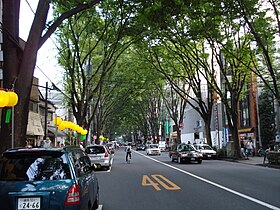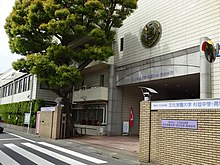world.wikisort.org - Japan
Suginami (杉並区, Suginami-ku) is a special ward in Tokyo, Japan. The ward refers to itself as Suginami City in English.
This article uses bare URLs, which are uninformative and vulnerable to link rot. (August 2022) |
This article needs additional citations for verification. (July 2009) |
Suginami
杉並区 | |
|---|---|
| Suginami City | |
 Wadabori Koen Park, spring cherry blossom | |
 Flag  Seal | |
 Location of Suginami in Tokyo | |
 Suginami Location in Japan | |
| Coordinates: 35°41′N 139°37′E | |
| Country | Japan |
| Region | Kantō |
| Prefecture | Tokyo |
| First official recorded | 4th century |
| As Tokyo City | October 1, 1932 |
| As Special ward of Tokyo | July 1, 1943 |
| Government | |
| • Mayor | Satoko Kishimoto (since July 11, 2022) |
| Area | |
| • Total | 34.06 km2 (13.15 sq mi) |
| Population (June 1, 2022) | |
| • Total | 588,354 |
| • Density | 17,274/km2 (44,740/sq mi) |
| Time zone | UTC+09:00 (JST) |
| Postal code(s) | 166-xxxx |
| City hall address | 1-15-1 Asagaya Minami, Suginami-ku, Tokyo 165-8570 |
| Website | www |
| Symbols | |
| Tree | Pine, Dawn Redwood, Sasanqua |
As of June 1, 2022, Suginami has an estimated population of 588,354 and a population density of 17,274 persons per km2.[1] The total area is 34.06 km2.
Geography
Suginami occupies the western part of the ward area of Tokyo. Its neighbors include these special wards: to the east, Shibuya and Nakano; to the north, Nerima; and to the south, Setagaya. Its western neighbors are the cities of Mitaka and Musashino.
The Kanda River passes through Suginami. The Zenpukuji river originates from Zenpukuji Park in western Suginami, and the Myōshōji River originates in Myōshōji Park, to the north of Ogikubo station.
History
The name Suginami dates back to the early Edo period and is a shortened version of Suginamiki ("avenue of cedars"). This name came about when an early land baron, Lord Tadayoshi Okabe, planted a row of cedar trees to mark the bounds of his property.[2]
The ward was founded on March 15, 1947.
In 1970, 40 high school students in the area were exposed to photochemical smog and required hospitalization. The incident attracted national attention and increased awareness of the dangers of pollution.[2]
Districts and neighborhoods



The following neighborhoods make up Suginami-ku.
|
|
Politics
Historically, Suginami has leaned toward liberal activism.[3] In 1954, local housewives launched the "Suginami Appeal" against nuclear weapons, a petition that spread nationwide and ultimately collected 20 million signatures.[2] More recently in 2005, Suginami became part of Japan's fight against nationalist textbook revisionism when residents petitioned Tokyo's courts to prevent the adoption of a controversial textbook published by Fusosha Publishing which claimed to justify Japanese actions during World War II.[2] The ward has also passed an ordinance placing limits on the installation of security cameras.[2]
To combat burglaries, which reached a record number of 1,710 in 2002, the ward created an unconventional anti-crime program called Operation Flower. The ward urged residents to plant flowers facing the street, with the long-term goal of increasing neighborhood watchfulness (necessitated by watering and otherwise attending to the plants). In addition, 9,600 volunteers were recruited for neighborhood safety patrols, 200 security cameras were placed at crime-vulnerable areas, and a daily email update was created for residents. Subsequent to the start of the program, burglaries were down 80% to 390 in 2008.[4]
Suginami refused to connect to Japan's Residents Basic Registry Network.[2] As of 2005, it is implementing a measure to make registry optional.[citation needed]
On June 19, 2022, Satoko Kishimoto was elected mayor despite being a long-time resident of Belgium and not having any connections to the ward. She narrowly defeated 3-term incumbent Ryō Tanaka by less than 200 votes. Kishimoto had come to prominence through online political debates during the COVID-19 pandemic.[5][6] Kishimoto has opposed building new road extensions through Kōenji district and the privatization of public facilities.[3]
Transportation
Rail
- JR East
- Chūō Main Line (Chūō-Sobu Line): Koenji, Asagaya, Ogikubo, Nishi-Ogikubo Stations
- Keio Corporation
- Keio Line: Hachiman-yama Station, Roka-kōen Station
- Keio Inokashira Line: Eifuku-cho, Nishi Eifuku, Hamada-yama, Takaido, Fujimi-ga-oka, Kuga-yama Stations
- Seibu Railway
- Seibu Shinjuku Line: Shimo-Igusa, Iogi, Kami-Igusa Stations
- Tokyo Metro
- Tokyo Metro Marunouchi Line: Honancho (branch line); Higashi Koenji, Shin-Koenji, Minami Asagaya, Ogikubo Stations
Road
- National highways: Route 20, the Kōshū Kaidō
- Kan-nana Dori (Number 7 Ring Road)
- Kan-pachi Dori (Number 8 Ring Road)
- Itsukaichi Kaidō (Suginami Akiruno Line, Tokyo Metropolitan Road Route 7)
- Ōme Kaidō
Education
Suginami City operates public elementary and junior high schools.

Public high schools are operated by the Tokyo Metropolitan Government Board of Education.
- Nishi High School[7]
- Nogei High School[8]
- Ogikubo High School[9]
- Suginami High School[10]
- Suginami Sogo High School[11]
- Suginami Technical High School[12]
- Toyotama High School[13]
International schools:
- Bunka Suginami Canadian International School[14][15]
- Tokyo Korean 9th Elementary School (東京朝鮮第九初級学校) - North Korean school[16]
Higher Education:
- Meiji University, Izumi Campus
Economy
Animation
Several animation studios are located in Suginami. Bones is headquartered in Igusa,[17] while Sunrise has its headquarters near the Kami-Igusa Station on the Seibu Shinjuku Line.[18] Bones was founded by former members of Sunrise, and staff at each company often help each other on projects. The Satelight studio, founded in Sapporo, relocated to the Asagaya neighborhood in 2006 (an earlier Tokyo office, at a different location in Suginami, had been in existence since 2003).[19] In addition, many smaller studios are based here; as of 2006, over 70 studios (of 400 throughout Japan) were located in Suginami.[2]
Japanese operations
The communications and electronics giant Iwatsu Electric is headquartered in Kugayama.[20]
Foreign operations
American Express used to have its headquarters located in a building south of Ogikubo station but it moved to a location in central Tokyo in 2020.
Microsoft has a branch office in the Daitabashi Asahi Seimei Building in Izumi.[21]
Former economic operations
Prior to its disestablishment, Data East had its headquarters in Suginami.[22]
Culture

- Ōmiya Hachiman Shrine
- Suginami Kokaido: a concert hall and the home of the Japan Philharmonic Orchestra.[2] It is also the same place where Birth of Ultraman (ウルトラマン誕生, Urutoraman Tanjō), the pre-premiere special of Ultraman was held which recorded on July 9, 1966 and later aired on Tokyo Broadcasting System (the Ultra Series' original network before TV Tokyo) the next day in 7:00 pm. In fact, as a tribute to the 50th anniversary of the Ultra Series, "Ultraman Day" (ウルトラマンの日, Urutoraman no Hi) was held in Suginami Kokaido on July 10, 2016.[23][24]
- Suginami Animation Museum: a small museum which includes a screening theater, library, and historical overview of Japanese animation, with English language explanations
References
- "東京都の人口". Statistics of Tokyo. Retrieved 11 July 2022.
- "Getting animated in Suginami". The Japan Times. 7 April 2006. Retrieved July 9, 2010.
- Hornyak, Tim (18 August 2022). "No backpedaling for Suginami Ward's bicycling mayor". Archived from the original on 29 August 2022. Retrieved 12 November 2022.
- Kubota, Yoko (June 12, 2009). "Residents fight burglars with flower power". Reuters. Retrieved July 9, 2010.
- INC, SANKEI DIGITAL (2022-06-20). "東京・杉並区長に岸本氏初当選 野党系が推薦". 産経ニュース (in Japanese). Retrieved 2022-06-21.
- "Tokyo mayoral win a 'huge surprise' for candidate lately arrived from Belgium". The Guardian. 21 June 2022. Retrieved 2 July 2022.
- "都立 西高等学校ホームページ". www.nishi-h.metro.tokyo.jp. Archived from the original on June 12, 2006.
- 都立農芸高等学校:Tokyo Metropolitan Nogei High School. Nogei-h.metro.tokyo.jp. Retrieved 2014-07-29.
- http://www.ogikubo-h.metro.tokyo.jp/
- 東京都立杉並高等学校. Suginami-h.metro.tokyo.jp. Retrieved 2014-07-29.
- http://www.suginamisogo-h.metro.tokyo.jp/
- 東京都立杉並工業高等学校. Suginamikogyo-h.metro.tokyo.jp. Retrieved 2014-07-29.
- http://www.toyotama-h.metro.tokyo.jp/
- "BSCIS: BRITISH COLUMBIA CERTIFIED OFFSHORE SCHOOL IN TOKYO". Bunka Suignami Canadian International School. Retrieved 29 September 2022.
- "| Bunka Suginami Canadian International School". bscis.bunsugi.jp (in Japanese). Retrieved 2017-10-23.
- ウリハッキョ一覧. Chongryon. Retrieved October 14, 2015. (Archive).
- "company info." Bones. Retrieved on March 10, 2010.
- "Company Outline." Sunrise. Retrieved on February 26, 2010.
- "Satelight Corporate History." Satelight. Retrieved on July 9, 2010.
- "Corporate Profile." Iwatsu Electric. December 8, 2002. Retrieved on July 9, 2010.
- "Microsoft Careers - Our Japan Locations." Microsoft. Retrieved on July 9, 2010.
- "データイースト." Data East. December 8, 2002. Retrieved on October 20, 2009.
- ウルトラマン放送開始50年記念『ウルトラマンの日 in 杉並公会堂』2DAYS開催決定!! 7/9(土)「THE ROCK 2016」・10(日)「THE LEGENDS 1966」. 円谷ステーション - ウルトラマン、円谷プロ公式サイト (in Japanese). m-78.jp. 2016-05-12. Retrieved 2016-05-25.
- ウルトラマンの日 (in Japanese). m-78.jp. Retrieved 2016-05-25.
External links
 Suginami travel guide from Wikivoyage
Suginami travel guide from Wikivoyage- Suginami City Official Website (in Japanese)
На других языках
[de] Suginami
Suginami (japanisch 杉並区, -ku) ist einer der 23 Stadtbezirke Tokios, der Hauptstadt Japans.- [en] Suginami
[es] Suginami (Tokio)
Suginami (杉並区, Suginami-ku?) es una región especial de la Metrópolis de Tokio, en Japón. Es común que la región especial se denomine a sí mismo como la Ciudad de Suginami. Creada el 15 de marzo de 1947, la región especial tenía en 2008 una población estimada de 536.657 habitantes, en un área de 34,02 km², está localizada en la parte occidental de la Metrópolis de Tokio. Por su territorio, atraviesan los ríos Kanda, Zenpukuji y Myoshoji.[ru] Сугинами
Сугинами (杉並区Сугинами-ку) – один из 23 специальных районов Токио. По состоянию на 1 мая 2020 года население составляло 588 405 чел, плотность населения – 17,276 чел/км², общая площадь района – 34,06 км².Другой контент может иметь иную лицензию. Перед использованием материалов сайта WikiSort.org внимательно изучите правила лицензирования конкретных элементов наполнения сайта.
WikiSort.org - проект по пересортировке и дополнению контента Википедии
